This pub is named after Sir John Baker who lived in North End House, close to this Wetherspoon pub. Sir John Baker, Lord Mayor of the Borough (1870 and 1875), was known as Honest John. He was a local MP, justice of the peace and chairman of the school board. Sir John was also the owner of several shops.
A quote regarding Sir John Baker.
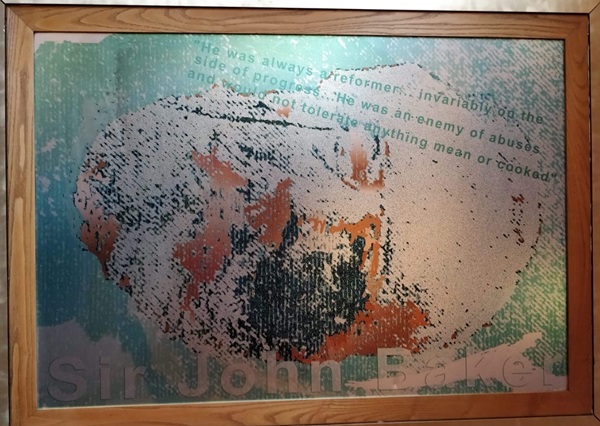
“He was always a reformer… invariably on the side of progress… he was an enemy of abuses and would not tolerate anything mean or crooked”.
Prints and text about Jonas Hanway.
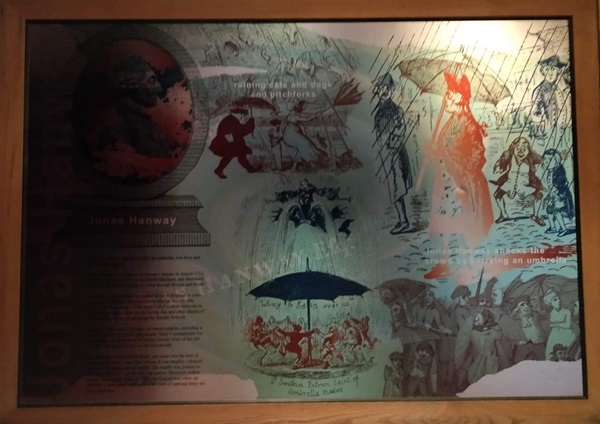
The text reads: The first man in England to carry an umbrella, was born and lived in Portsmouth.
Jonas Hanway was born at St George’s Square in August 1712. He was apprenticed at 17 to a Lisbon merchant, and afterwards traded at St Petersburg and travelled through Russia and Persia.
After inheriting a fortune, he settled down in England to some serious philanthropy. He founded the Marine Society (the oldest maritime charity in the world), and worked tirelessly to help child chimney sweeps, and to ban this and other abuses of children, as well as campaigning for Sunday Schools.
Hanway wrote some 74 books, on varied subjects, including a diatribe against gratuities. He became Navy Commissioner for Victualling and spent most of the last twenty years of his life based at the Square Tower in Old Portsmouth.
His umbrella, which turned heads, and made him the butt of scorn and derision, came from Persia. It was brightly coloured with an elaborately carved handle. The handle was jointed so that he could fold it up into his coat pocket. However, within twenty years of his death, in 1786, the English had taken up Hanway’s innovation, and made it the item of national dress we know and love.
Prints and text about Isambard Kingdom Brunel.
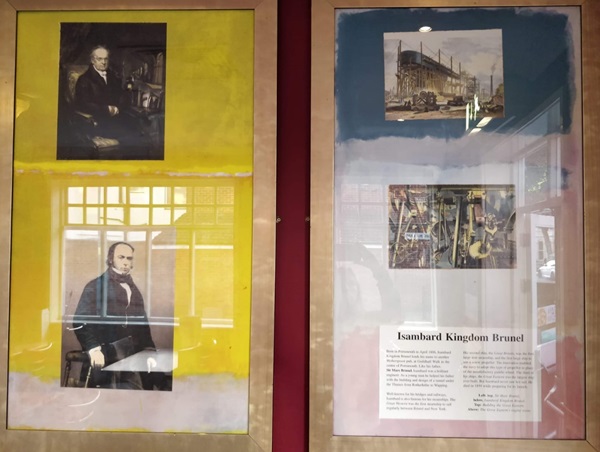
The text reads: Born in Portsmouth in April 1806, Isambard Kingdom Brunel lends his name to another Wetherspoon pub, at Guildhall Walk in the centre of Portsmouth. Like his father, Sir Marc Brunel, Isambard was a brilliant engineer. As a young man he helped his father with the building and design of a tunnel under the Thames from Rotherhithe and Wapping.
Well known for his bridges and railways, Isambard is also famous for his steamships. The Great Western was the first steamship to sail regularly between Bristol and New York.
His second ship, the Great Britain, was the first large iron steamship and the first large ship to use a screw propeller. The innovation enabled the navy to adopt this type of propeller in place of the unsatisfactory paddle-wheel. The third of his ships, the Great Eastern was the largest ship ever built. But Isambard never saw her set sail. He died in 1859 while preparing for its launch.
Top: Building the Great Eastern
Above: The Great Eastern’s engine room.
Prints and text about John Pounds.
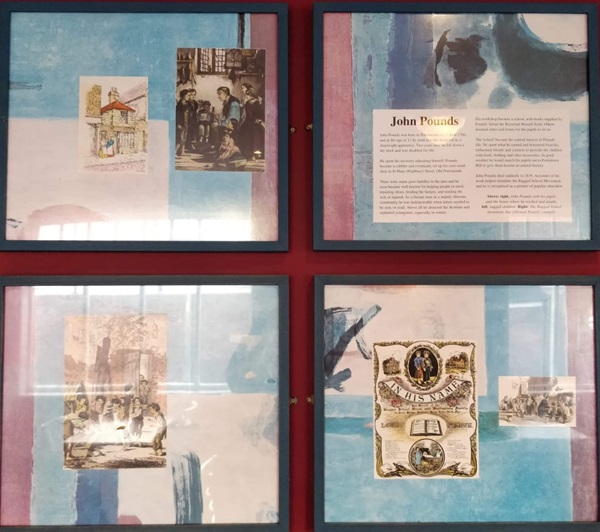
The text reads: John Pounds was born in Portsmouth on 17 June 1766, and at the age of 12 he went into the dockyard as a shipwright apprentice. Two years later he fell down a fry dock and was disabled for life.
He spent his recovery educating himself, Pounds became a cobbler and eventually set up his own small shop in St Mary (Highbury) Street, Old Portsmouth.
There were many poor families in the area and he soon became well known for helping people in need, repairing shoes, feeding the hungry, and tending the sick or injured. As a literate man in a mainly illiterate community he was indispensable when letters needed to be read, or sent. Above all he attracted the destitute and orphaned youngsters, especially in winter.
His workshop became a school, with books supplied by Pounds’ friend the Reverend Russell Scott. Others donated slates and forms for the pupils to sit on.
The ‘school’ became the central interest of Pounds’ life. He spent was he earned and borrowed from his influential friends and contacts to provide the children with food, clothing and other necessities. In good weather he would march his pupils out the Portsdown Hill to give them lessons in natural history.
John Pounds died suddenly in 1839. Accounts of his work helped stimulate the Ragged School Movement, and he is recognised as a pioneer of popular education.
Above: right, John Pounds with his pupils and the house where he worked and taught, left, ragged children
Right: The Ragged School movement that follows Pounds’ example.
Prints and text about Charles Dickens.
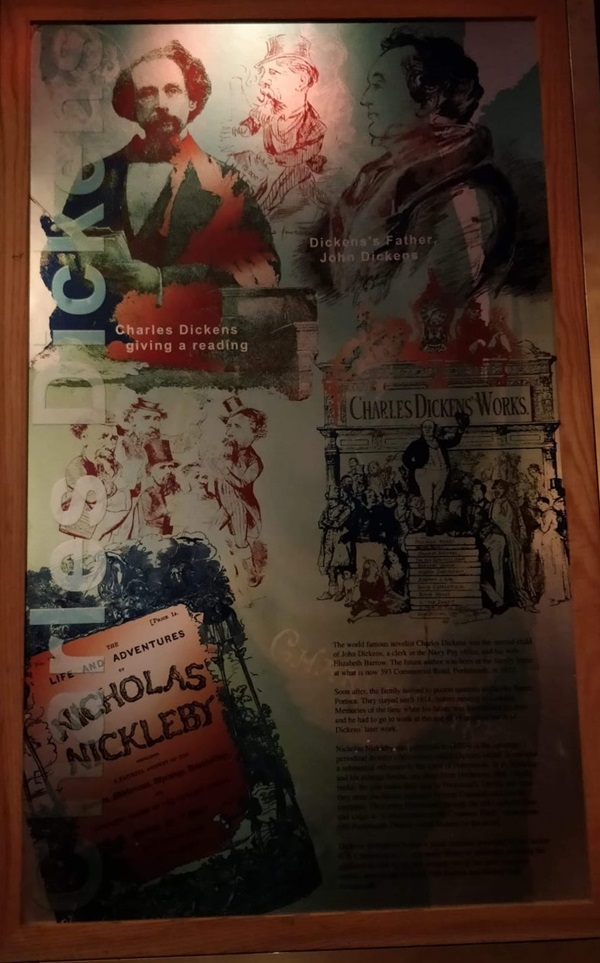
The text reads: The world famous novelist Charles Dickens was the second child of John Dickens, a clerk in the Navy Pay office, and his wife Elizabeth Barrow. The future author was born at the family home at what is now 393 Commercial Road, Portsmouth, in 1812.
Soon after, the family moved to poorer quarters in Hawke Street, Portsea. Hey stayed until 1814, before moving to London. Memories of the time when his father was imprisoned for debt and he had to go to work at the age of 12 inspired much of Dickens’ later work.
Nicholas Nickleby was published in 1838-9 in the monthly periodical Bentley’s Miscellany which Dickens edited. It contains a substantial reference to the town of Portsmouth. In it, Nicholas and his protégé Smike, run away from Dotheboys Hall. Utterly broke, the pair made their way to Portsmouth. During this time, they meet the theatre manager Vincent Crummle and join his company. They enter Portsmouth through the old Landport Gate and lodge at “a tobacconists on the Common Hard”, close to the Old Portsmouth Theatre which features in the novel.
Dickens’ birthplace is now a small museum described by the writer G K Chesterton as “… a popular shrine or memorial, enabling the sightseer to link up on one journey two of the most romantic names, associating Dickens with Portsea and Nelson with Portsmouth”.
An acrylic painting of Grays Ltd – Motor Cycle Agents No 31 Kingston Road, by Simon Harmer.
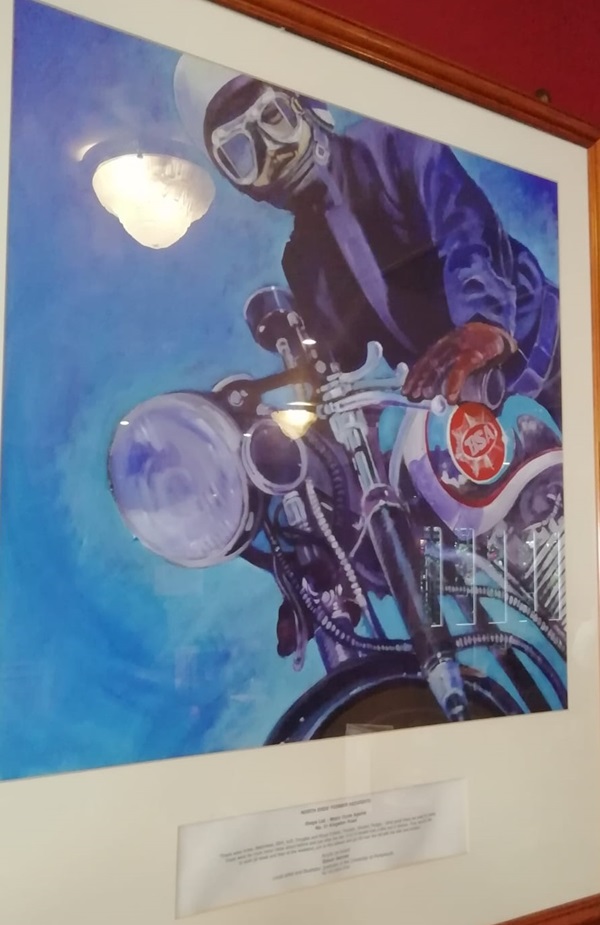
External photograph of the building – main entrance.
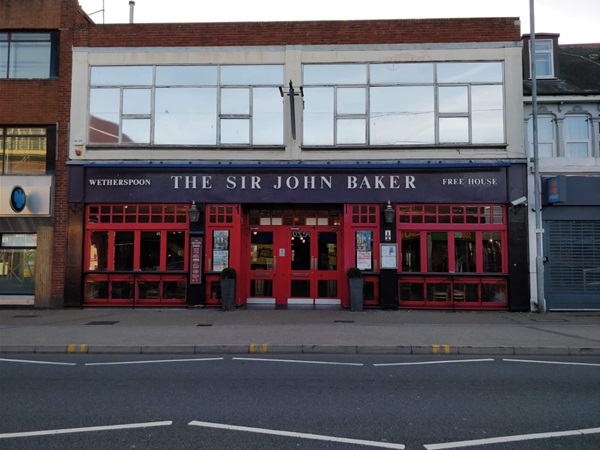
If you have information on the history of this pub, then we’d like you to share it with us. Please e-mail all information to: pubhistories@jdwetherspoon.co.uk